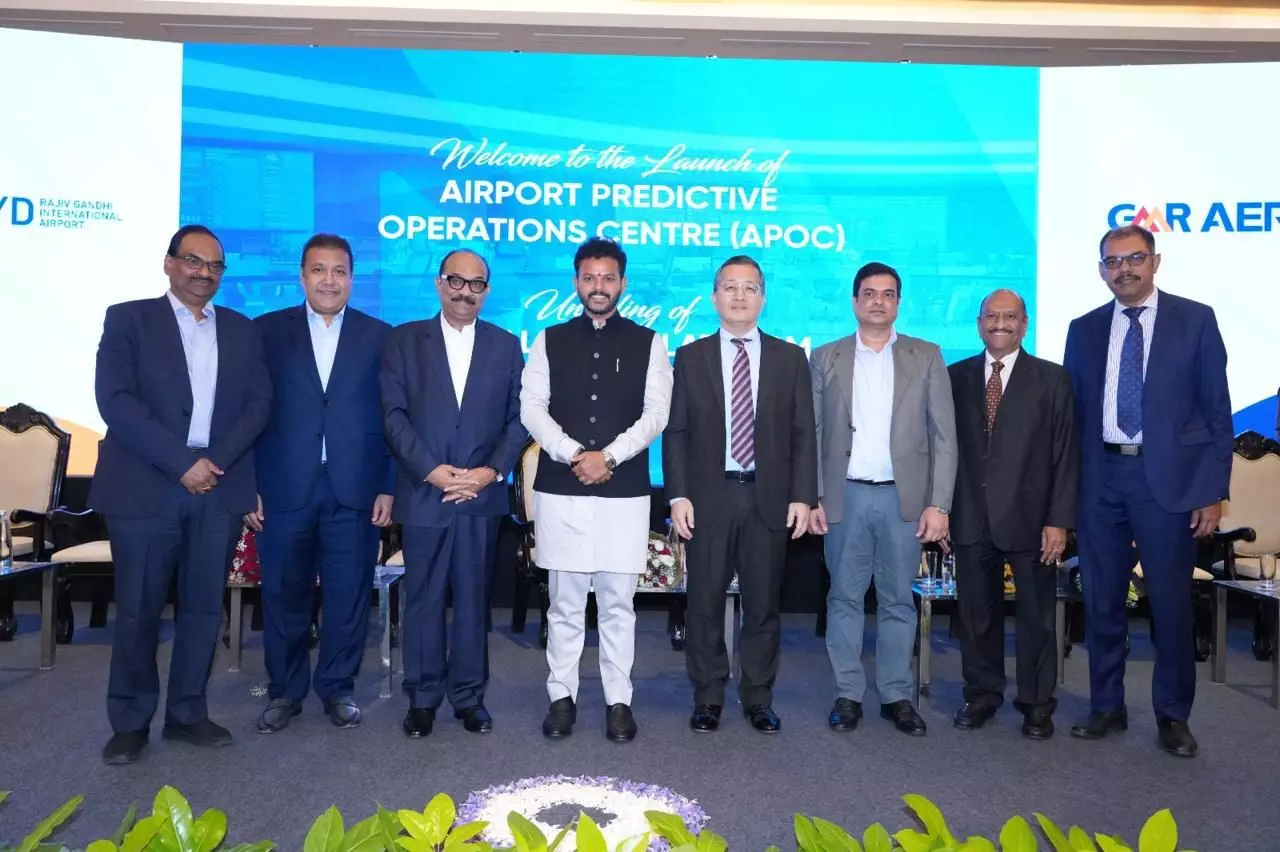GMR may consider second runway, terminal at Hyderabad Airport once pax hits 45 million: Official
Currently, the airport has one integrated terminal
By Anoushka Caroline Williams
Union Civil Aviation Minister K Ramamohan Naidu at Rajiv Gandhi International Airport
Hyderabad: GMR Group which manages the Rajiv Gandhi International Airport here may consider adding another terminal and second runway once the passenger traffic hits 45 million annually, a senior official of the airport infra major said.
On Wednesday, SGK Kishore, Executive Director and Chief Innovation Officer of GMR Airports, at a press conference exuded confidence that the passenger traffic would hit 45 million (annually) by 2030 from the existing 30 million and said the ultimate of the airport would be 100 million passengers.
"We are expecting 45 million (per annum) by 2030. It is only an estimate and anything can happen. Based on the projections and based on what we have seen, we have to be proactive. We have started the planning (for the capacity expansion)," he said.
The GMR Hyderabad International Airport Ltd has already created the necessary infrastructure in a phased manner to handle 34 million passengers. The aerodrome was built in 2008 with a capacity of 12 million. Currently, the airport has one integrated terminal.
AI-Powered digital twin platform launched
In a step towards redefining airport operations, Rajiv Gandhi International Airport (RGIA) in Hyderabad has launched an Artificial Intelligence (AI)-powered digital twin platform alongside the Airport Predictive Operation Centre (APOC). It is the first airport in India with such a system.
This system is set to enhance operational efficiency, reduce disruptions, and improve passenger experiences by integrating real-time data across all aspects of airport functioning.
GMR Airports, which operates RGIA, aims to make operations more predictable and efficient while setting a new benchmark in passenger management.
Breaking down APOC: How it works
The APOC unites various facets of airport operations—airside, terminal, landside, and technical services—under a single digital platform. The system uses real-time data and analytics to identify and resolve issues proactively, ensuring smoother passenger movement and operational synergy.
SGK Kishore, Executive Director (South) and Chief Innovation Officer of GMR Airports, explained the vision behind the project: “The APOC brings together all stakeholders, enabling proactive responses to operational challenges. Our goal is to use advanced technology to not only enhance efficiency but also redefine the passenger experience at every step.”
The system operates through distinct “islands,” each focusing on specific areas:
Stakeholder Island
Facilitates collaboration among airlines, ground handlers, and immigration officials, ensuring quick turnarounds and efficient baggage and cargo handling.
Airside Island
Monitors aircraft parking stands, bird movement, and ground safety violations. It also addresses emergencies and ensures smooth airside operations.
Terminal Island
Tracks passenger flow from entry to boarding, manages congestion, and oversees security checks and baggage handling.
Landside Island
Optimizes vehicular traffic, parking, and cab availability for smooth passenger entry and exit.
Technical Island (Digital Twin)
Monitors systems like air conditioning, lighting, and baggage belts to ensure seamless maintenance.
Passenger-Centric Innovation
“At the heart of the APOC’s design is the passenger” said Kishore.
The system uses real-time monitoring to identify and resolve congestion, improve security processes, and provide real-time updates to passengers. The recently launched HOI app allows travelers to access updates and seek assistance, further improving their journey.
“Before the passenger demands it, this system will help in servicing them,” said Kishore. “We’re aiming to increase Hyderabad airport’s passenger capacity from 30 million to 45 million annually over the next three to four years through systematic improvements.”
Boosting Efficiency and Reducing Disruptions
The APOC has already begun delivering results. Rahul Sandilya, Head of Digital Transformation at GMR, highlighted its role in crisis management: “From flight delays to severe weather conditions, the APOC provides real-time solutions to mitigate disruptions. It also facilitates collaborative decision-making by bringing together all stakeholders under one platform.”
Hyderabad Airport currently handles 43 flights per hour, with plans to increase this to 50 and eventually 55 with systematic upgrades. The digital twin platform also enables virtual simulations, helping the airport plan for scenarios like emergencies or peak-hour congestion.
The unveiling attended by Union Civil Aviation Minister Kinjarapu Ram Mohan Naidu and Telangana Minister Komatireddy Venkat Reddy, marks a technological leap for Indian airports.
A Vision for the Future
The APOC’s implementation at Hyderabad Airport is just the beginning. GMR Airports plans to roll out this advanced technology across all its operations. “This system is not static,” said Mr. Kishore. “It’s dynamic and will evolve based on the data and experiences we gather.”
“With the APOC and digital twin platform, RGIA has positioned itself as a global leader in airport innovation, setting a precedent for the future of air travel” Kishore concluded.